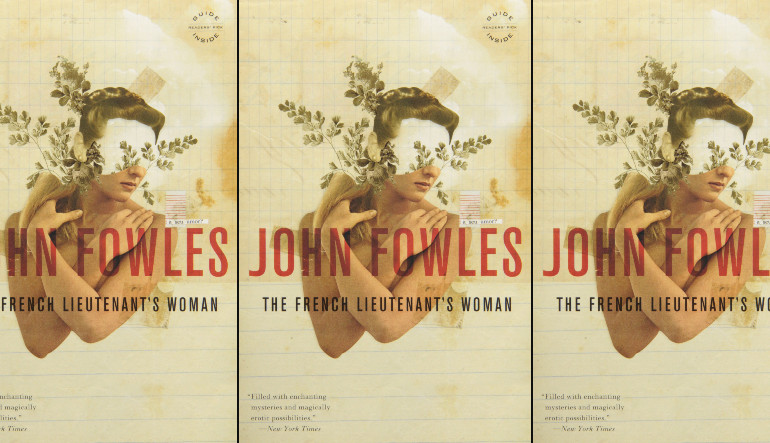Fictional Writer Master Class: Fowles and the Fiction Bender

“But rather, what the devil am I going to do with you?”
In John Fowles’s The French Lieutenant’s Woman, the unnamed narrator poses this question to himself about the character sleeping before him. Only he isn’t just the narrator; he’s much more than that. He’s part of a group of fictional writers I’ll call Fiction Benders—characters and narrators who bend the rules of narrative.
The Benders differ from editorial omniscience, sly narratorial commentary, or the ever popular unreliable narrator. Instead, the Benders elevate authorial interference and self-reflexiveness to a new level. Stranger than Fiction, the quirky-in-a-good-way comedy starring Emma Thompson and Will Ferrell, features Thompson as a writer narrating and dictating Ferrell’s world. Or consider Adaptation, in which Nicholas Cage plays twin brothers trying to adapt Susan Orlean’s non-fiction book The Orchid Thief. The real twist? Screenwriter Charlie Kauffman made up a fictional co-writing twin brother who is listed in the credits. Call it silly, call it meta: I call it brilliant.
Perhaps I’m a sucker for Fiction Benders because I fell in love with them while reading Fowles. The French Lieutenant’s Woman, written in 1969, at cursory glance seems to be a piece of historical fiction. It focuses on Charles Smithson, who, in grand Edith Wharton style, is caught in a love triangle between good girl Ernestina, whom he plans to marry, and lonely woman of ill-repute, Sarah, on whom he is fixated (borderline stalking, some might say). Fowles uses his editorial narrator to comment on characters, Victorian society, and literary doctrine. For me, however, it is the train sequence that is the most impressive.

Author John Fowles
Late in the novel, Charles boards a London-bound train and is joined by a middle-aged, “decidedly unpleasant man.” Charles nods off, ignoring his traveling companion. His fellow traveler, however, begins staring at Charles with ferocious intensity.
“You may one day come under a similar gaze,” the reader is warned. The watcher is devious, a violator of privacy.
In my experience, there is only one profession that gives that particular look, with its bizarre blend of the inquisitive and the magisterial; of the ironic and the soliciting.
Now could I use you?
Now what could I do with you?
It is precisely, it has always seemed to me, the look an omnipotent god—if there were such an absurd thing—should be shown to have . . . I see this particular clarity on the face, only too familiar to me, of the bearded man who stares at Charles. And I will keep up pretense no longer.
Fowles then reveals that rather than construct an author avatar, he has written himself into the story. Earlier in the book his narrator has clarified the line between author and narrator, possibly just for the fun of blurring that line in this later scene. He toys with what to do with Charles—leave him suspended in narrative purgatory, forever bound to London on a train that never arrives? Fowles questions his control over the characters, claiming he can’t make decisions for the protagonist, Sarah, who is neither present nor clear in her desires. Instead he sits on the train, watching Charles and debating what to do with him next:
Fiction usually pretends to conform to reality: the writer puts the conflicting wants in the ring and then describes the fight—but in fact fixes the fight, letting that want he himself favors win. And we judge writers of fiction both by the skill show in fixing fights (in other words, persuading us that they were not fixed) and by the kind of fighter they fix in favor of: the good one, the tragic one, the evil one, the funny one, and so on.
But the chief argument for fight-fixing is to show one’s readers what one thinks of the world around one—whether one is a pessimist, an optimist, what you will.
Fowles decides then that rather than fixing a fight, in part because he already knows what has come to pass in the 100 years between his train ride with Charles and the time of the novel’s writing, he will give two versions of the fight. With a flip of a coin, he does just that.
The first time I read this passage, I was captivated. My cynical nature usually calls foul on such contrivances—maybe because breaking the fourth wall and alternate endings stopped feeling fresh with Clue and Wayne’s World. Where Fowles sold me was in his argument. He takes two basic concepts of writing—conflict and characters—and through the lens of this scene makes a simple yet effective analogy.
 If writers do, as Fowles attests, fix fights for the want they favor, how can we account for those unhappy, heartbreaking endings (I’m looking at you, Where the Red Fern Grows)? In that case, unless the author is a sadist, s/he may either a.) be trying to make the fight look as if it is not fixed by giving the opposite outcome they desire, or b.) making a great thematic point. When we resolve narrative conflicts, how do we select the outcome? How do we concoct an ending that is at once authentic to the story, yet also not predictable?
If writers do, as Fowles attests, fix fights for the want they favor, how can we account for those unhappy, heartbreaking endings (I’m looking at you, Where the Red Fern Grows)? In that case, unless the author is a sadist, s/he may either a.) be trying to make the fight look as if it is not fixed by giving the opposite outcome they desire, or b.) making a great thematic point. When we resolve narrative conflicts, how do we select the outcome? How do we concoct an ending that is at once authentic to the story, yet also not predictable?
Fowles presents the solution of a Denouement Buffet—he’ll give readers choices to sample and they can decide which is to their liking. Even though we can’t all do that, what if, rather than sticking to the ‘fixed ending,’ we write multiple outcomes? As an exercise, consider drafting endings contrary to the one you first had in mind. Go opposite, extreme, silly, wild, romantic, Scooby-Doo—sometimes the right ending may be the one that always seemed wrong.
The Fiction Bender of The French Lieutenant’s Woman argues in several places that his characters have slipped from his grasp and are beyond his control. Manipulating them causes an internal conflict that culminates in the train scene. Some writers talk about characters taking on a life all their own—to non-writers, that can sound ridiculous. However, well-developed characters, if only in the writer’s notes, are more able to act organically.
While your reader may never need to know that the protagonist hates fried chicken because she always had to eat the leftovers after the church picnic, knowing those types of details that build a life for an imaginary figure can aid the writer in developing their wants and actions organically. Then it is not that the author is manipulating the character for an intended outcome, but allowing the character to respond authentically in the circumstances. The character, in essence, is now in control.
The line between author and narrator may be thin, but the Fiction Benders remind us how malleable the world we write in can be. And sometimes what seem to be lines are only illusions.



